The Scene in Cinema – WEEK 1 – Scene Breakdown.
Joel & Ethan Coen’s ‘The Big Lebowski’ (2000) Sc. ‘You’re Entering a World of Pain’.
To get an idea of why this scene is constructed and covered the way that it is, a context for the film is needed to be explained, in order to support my analysis and deconstruction.
BRIEF: Joel and Ethan Coen’s ‘The Big Lebowski’ is an unusual farcical comedy about a down and out Geoffery Lebowski, or ‘The Dude’ who cannot seem to let go of the Sixties ‘flower-power’ era. His accompanied friends being a Jewish convert, Vietnam War veteran named Walter Sobchack, and Donny Kerabatsos, a socially awkward and comical punching bag for Walter. The whole objective for the protagonist is to simply ‘get his rug back’, but he is tied into a story of mistaken identity, kidnapping, nihilists, and a neo-noir crime mystery, to which he is employed as a private eye. The film is satirical of its own silliness and is stylistically encouraging of an abstract and ridiculous construction of the film. The film’s foundation for a driven narrative is the trio’s desire to compete and win a local bowling competition. The purpose for bowling to be the main foundation is that it is reminiscent of the 1950’s and 60’s when bowling was at its most popular. Considering that the film is set in the 1990’s, it is only right that bowling be the choice, as it serves as a reflection of the three characters that cannot let go of the past, therefore encouraging a sense of denial, ridiculousness and comedy throughout the film.
As we now have an understanding of the nature of the film, we can now delve into this scene’s deconstruction and analysis.
In the beginning of the scene, we can see Donny bowl a strike, to which he turns around in speed with excitement. As he walks towards the camera, the shot pans to Donny’s waist and then stops, as he walks out of frame. What we are left to gaze at is the opposing bowling team looking intimidated at Donny’s comments. The shot then jumps to the back of a bowling member, walking up the stairs so he can veer around to the lobby, with Walter walking parallel to him in the opposite direction, towards the camera. The camera maintains a continuous unbroken shot, as Walter sits down to the right of frame, next to The Dude, and Donny on the left. However, Donny is captured by the camera at center frame in the background to show his reclusiveness in The Dude and Walter’s bickering and banter. He will commonly intrude half way through the conversations, to which he is bayed off by Walter with a ‘Shut the f*** up, Donny’, which serves to enhance the comedic tone to the scene. 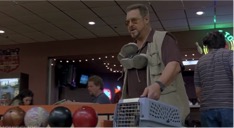
The way these two shots have worked together is by creating a fast paced movement throughout the particular location in the bowling alley. This has catered to show more than half of the set, to give the audience orientation to the character’s surroundings, as well as introduce all three characters in the scene fluidly. The shot also allows for each character to be positioned in the rule of thirds, while showing each character as primary and secondary by how close they are to the camera. For example, The Dude (the protagonist) is in the foreground, Walter (his best friend) is in the middle ground, and Donny (the silent, but necessary tag-along) is in the background. However, while Donny is in the background, he is in the middle. This reflects how he is the glue between The Dude and Walter’s friendship, which is shown to deteriorate after Donny’s death, later in the narrative. 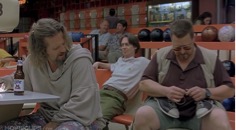
Analysing the Coen’s reasons for certain camera angles and shots is always fraught with the possibility of reading into unintended meaning behind them, hence, I will now analyse this with a grain of salt, so to speak.
While this one still shot of the trio is briefly broken to show Walter’s ex-partner’s Pomeranian which he has brought to the bowling alley with him, the still shot remains focused on this portrait of their banter. That is until Walter suddenly yells “Over the line!” mid conversation, to an opposing bowler that they are competing with. The scene has now gone from a menial conflict over Pomeranians to a bowling technicality battle between Walter and ‘Smokey’. The shot then cuts to Smokey standing at the edge of the bowling lane, turned and confused at Walter’s exclamation. The positioning of Smokey is in the dead center of the frame, with a lot of headroom. This creates the isolation and ostracism that Smokey feels, as he has just been yelled at, rather than conversed with. This would come across unusual in a relaxed sport like bowling. This also serves to kick start the tension that will now unfold, immediately layering over the ridiculousness and comedy of the scene. The scene then turns into an argument between Walter and Smokey over whether or not Smokey’s toe was “over the line” which would result in a technical foul, and a score of zero. The scene intensifies, as Smokey combats Walter over this issue, by getting closer to Walter, and the frame becoming tighter around the character, reflecting his argumentative behavior.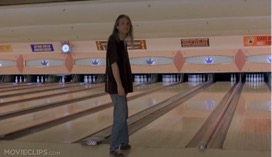
For the second time in the scene, we see a swing pan of the camera, but this time it is focused on Smokey, walking over to the scoring table to “mark it an eight”. The purpose of this is to show Smokey’s swoop into marking the score sheet with an eight to his name, initiating Walter’s outrageous reaction turned from verbal to physical. The camera then jumps to Walter pulling a pistol from his bowling bag and preparing it to fire. 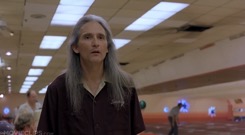 This gives the audience a close look into what Walter is currently unwrapping, pre-empting a surprised and sense of disbelief from the audience. The fact that a character would pull a gun on another over an argument about bowling serves to get in-touch with the style of the film as a ridiculous and hilarious series of events.
This gives the audience a close look into what Walter is currently unwrapping, pre-empting a surprised and sense of disbelief from the audience. The fact that a character would pull a gun on another over an argument about bowling serves to get in-touch with the style of the film as a ridiculous and hilarious series of events. 
The camera shots then turn to a series of cuts between a high angle medium close up of Walter and The Dude, and a close up of Smokey, as he is stunned with fear at the presence of the gun. The high camera angle over Walter’s serious face as he holds his pistol beside his head in a threatening way is used to communicate Walter’s emotion, and that he is ready to get out of his chair. 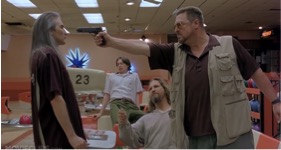 The reason that I believe that he will rise from his chair is because the high angle allows for the actor to stand and have his head still in the frame, due to the height that the camera is set up prior to the shot. It is an effective method to show the actor really ‘getting in your face’ and causing a feeling that the audience cannot escape the action on screen.
The reason that I believe that he will rise from his chair is because the high angle allows for the actor to stand and have his head still in the frame, due to the height that the camera is set up prior to the shot. It is an effective method to show the actor really ‘getting in your face’ and causing a feeling that the audience cannot escape the action on screen.
The two-shot involving Smokey and Walter’s altercation is a wide shot displaying all characters, their strange emotional reactions to the events, and the life and death situation playing out, once again enhances the comedic effect of the entire film as a weird farce of events with characters who are very mentally unstable. The Coen brothers mainly focus on style and audience reception among all other aspects of film, therefore the intimate analysis of such camera shots would lead one to gain an understanding of how they can capture and develop their styles so well.
This scene in particular is one of my favorites among cinema.